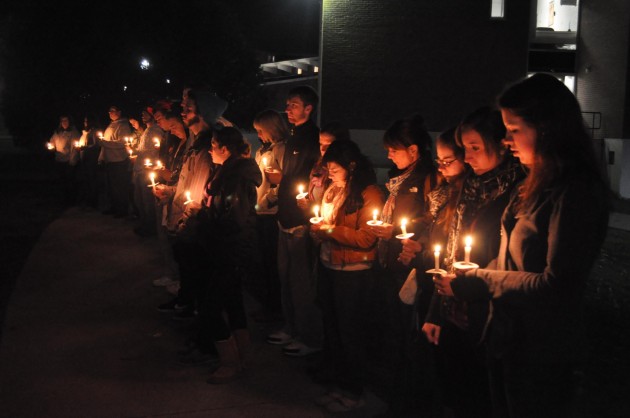Zombies attack CSC!
Things had taken a turn for the worse for the six survivors. Just two days after the infection had reached campus, they had run out of food and made the decision to venture to the cafeteria in search of more. Along the way they had encountered one or two “walkers” who were easily dispatched, but now was entirely different. Just beyond the steel doors, dozens of infected had gathered to make a survivors worst nightmare.
It was a horde, and they too were hungry.
The group knew it was only a matter of time before they were overrun and in a moment of indecision, they scattered. Two made a break for it between nearby buildings followed closely by several eager “runners.” Another two chose to retreat back inside, leaving the remaining to face down the rest of the pack.
Within seconds, it was down to one.
The lone survivor made his way to the closest building, firing off several rounds from his rifle into the circling crowd of flesh-eaters. Eventually, he brought them down to only three, inching his way backwards toward the safe house.
Turning to pry open the locked door, one of the fiends lurched at him. The survivor turned and raised his gun, but forgot a very important fact: The infected can still baseball-slide.
In mere minutes, he too had joined the ranks of the undead.
What sounds like a scene out of a horror film was actually part of the first ever Humans versus Zombies event at Castleton.
Zombie strategy
Tyrone Davenport was one of several “human” students ambushed at Huden Dining Hall after a call went out for all zombies to congregate on the campus green to hunt in a pack.
“I got sidetracked by a zombie and my gun jammed,” said Davenport removing his orange bandana from his arm and tying it to his forehead to signal his defeat. “I don’t really care, it’s fun either way. This shit is real!”
The weeklong event was sponsored by the Residence Hall Association to promote more student activities on campus. On Oct. 30, more than 90 students gathered in Castleton Hall to sign up for the game, but continual sign-up would boost that number to 130.
Players lined up to receive their I.D. cards and a copy of the game rules — and to show off their collections of Nerf Guns they would be using in the fight against the undead.
Coordinator of student activities Melissa Paradee says events like this are important for the campus.
“It was a really bizarre, but exciting event,” said Paradee, who hopes the event jump-starts other bonding events. “A lot of students like the concept of an apocalyptic battle, and being around Halloween it really allowed students to step out of reality.”
For students like Justin Happel, acting like a zombie was a welcome distraction from the mundane reality of schoolwork.
“I’m living a horror fantasy! Plus I get to act like a 12-year-old” said Happel who sent the e-mail prompting the already infected players to meet and work together.
Throughout the week, students could be seen in between classes racing to and from classes, chasing each other down and ambushing unsuspecting players in the game of freeze tag with a twist. Many human players congregated in the Fine Arts Center turning it into a makeshift base, and even going so far as painting their faces with camouflage.
Jacob LaBounty was the first to be “infected,” but reveled in his zombie role.
“I wanted to ruin their days!” said LaBounty xgleefully. Moments later he bounded down the sidewalk in front of the library tagging out a human and jumping over the brick divider to avoid retaliating Nerf fire, which would render him useless for 15 minutes.
Zombie craze
But Castleton State isn’t the only place in the world where zombies have taken over. Campuses and institutions all across America and even Europe are donning camouflage and loading their foam bullets to take part in the massively popular game.
But beyond the game, it is virtually impossible to go anywhere without encountering the zombie culture in some way.
Popular books such as World War Z and The Zombie Survival Guide have become best sellers for those fearful of a zombie pandemic.
Popular movies like Night of the Living Dead, the patriarch of zombie films, television shows such as The Walking Dead and especially videogames reach out to an even greater audience than that.
CSC film professor Roy Vestrich said zombies can tell us a lot about what is happening in our culture.
“It’s tribal storytelling that’s been around as long as there has been story telling,” said Vestrich.
In spring of 2008, a strong interest in zombies was what led to the creation of a student produced zombie film in one of Vestrich’s classes. The piece featured Zombies taking over a college facility in a similar fashion to the Humans vs. Zombies event, he said.
“They are partially us, and they are not us,” said Vestrich discussing their appeal. “Zombies cross all cultural barriers. They’re an equal opportunity flesh eater.”
A recent study done by Oxford University’s Internet Institute created a visual map of the phrase “Zombie” showing where on Earth the highest concentrations of the term were used. Not surprisingly North America and Europe were displayed as having the greatest concentration, while Africa, the country from where the tern originally came from, had the least.
The final battle
On Nov. 3 just before dusk, students playing the game were asked to meet in front of Ellis Hall on campus to receive instructions on the final battle to determine the winners.
In fewer than 20 minutes, the roughly 25 remaining human survivors were to reach four locations on the residential side of campus and collect four ribbons before returning to Ellis to make the antidote. Zombies could tag players anywhere but the front of the buildings and could only be frozen for two minutes.
Members of the Castleton community, both students and staff alike, came out to watch in awe as a massive free-for-all of Nerf darts and screams engulfed the campus.
The remaining humans started off strong, banding into tight-knit circle and making their way through campus feverously chanting an “Everywhere we go-oh!” song. However, by the end of the day, only eight humans survived against the onslaught of the undead hoard.
Theater Professor Harry McEnerny, who was a strong supporter of the event since its inception, was one of those looking on during the final battle.
“How can anyone not like zombies!” said McEnerny cheerfully. “The event was well organized, and it happened the way that you would think that an actual zombie Apocalypse would go down.”
A second game is already in the works for spring semester.








